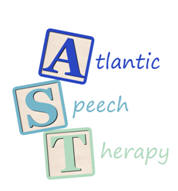3205 Randall Parkway
Suite 201
Wilmington, NC 28403
Phone: 910.343.5885
Home | About AST | Services | FAQs | Forms | Location
Speech and Language Milestones
What should my child be able to do?
Hearing and Understanding
Talking
Birth-3 Months
o Startles to loud sounds.
o Quiets or smiles when spoken to.
o Seems to recognize your voice and quiets if crying.
o Increases or decreases sucking behavior in response to sound.
Birth-3 Months
o Makes pleasure sounds (cooing, going).
o Cries differently for different needs.
o Smiles when sees you.
4-6 Months
o Moves Eyes in direction of sounds.
o Responds to changes in tone of your voice.
o Notices toys that make sounds.
o Pays attention to music.
4-6 Months
o Babbling sounds more speech-like with many different sounds, including p, b, and m.
o Chuckles and giggles.
o Vocalizes excitement and displeasure
o Makes gurgling sounds when left alone and when playing with you.
7 Months-1 Year
o Enjoys games like peek-o-boo and pat-a-cake.
o Turns and looks in direction of sounds.
o Listens when spoken to.
o Recognizes words for common items like “cup”, “shoe”, “book”, or “juice”.
o Begins to responds to requests (e.g. “Come here”, or “Want more?”).
7 Months-1 Year
o Babbling has both long and short groups of sounds such as “tata upup bibibibi.”
o Uses speech or non-crying sounds to get and keep attention.
o Uses gestures to communication (waving, holding arms to be picked up)
o Imitates different speech sounds.
o Has one or two words (hi, dog, dada, mama) around first birthday although sounds may not be clear.
One to Two Years
o Points to a few body parts when asked.
o Follows simple commands and understands simple questions (“Roll the ball”, “Kiss the baby”, Where’s your shoe?”).
o Listens to simple stories, songs, and rhymes.
o Points to pictures in a book when named.
One to Two Years
o Says more words every month.
o Uses some one- or two- word questions (“Where kitty?”, “Go bye-bye?”, “What’s that?”).
o Puts two words together (“more cookie”, “no juice”, “mommy book”).
o Uses many different consonant sounds at the beginning of words.
Two to Three Years
o Understands differences in meaning (“go-stop”, “in-on”, “big-little”, “up-down”).
o Follows two requests (“Get the book and put it on the table”).
o Listens to and enjoys hearing stories for longer periods of time.
Two to Three Years
o Has a word for almost everything.
o Uses two- or three- words to talk about and ask for things.
o Uses k, g, f, t, d, and n sounds.
o Speech is understood by familiar listeners most of the time.
o Often asks for or directs attention to objects by naming them.
Three to Four Years
o Hears you when you call from another room.
o Hears television or radio at the same loudness level as other family members.
o Answers simple, “who?”, “what?”, “where?”, “why?” questions.
Three to Four Years
o Talks about activities at school or at friends’ homes.
o People outside family usually understand child’s speech.
o Uses a lot of sentences that have 4 or more words.
o Usually talks easily without repeating syllables or words.
Four to Five Years
o Pays attention to a short story and answers simple questions about them.
o Hears and understands most of what is said at home and in school.
Four to Five Years
o Uses sentences that give lots of details (“The biggest peach is mine”).
o Tells stories that stick to topic.
o Communicates easily with other children and adults
o Says most sounds correctly except a few like l,s,r,v,z,ch,sh,th.
o Says rhyming words.
o Names some letters and numbers.
o Uses the same grammar as the rest of the family.
This information is available from the website: American Speech-Language Hearing Association.
3205 Randall Parkway Suite 201; Wilmington, NC 28403
Phone: 910.343.5885 | 910.679.8075 | Fax: 910.343.5886
